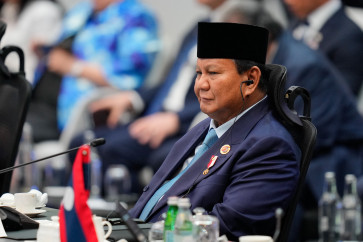Popular Reads
Top Results
Can't find what you're looking for?
View all search resultsPopular Reads
Top Results
Can't find what you're looking for?
View all search resultsPrioritizing the short term
Recent indicators suggest that Indonesia's recent challenges are centered on declining purchasing power.
Change text size
Gift Premium Articles
to Anyone
I
n the long run, we are all dead, according to a famous quote attributed to John Maynard Keynes. In short, the statement emphasizes the need for government intervention when the economy is facing a downturn.
Keynes was fundamentally opposed to the classical economists, who believed that the market would regulate itself through the invisible hand and thus opposed government intervention. Let us call the latter fiscal expansionism through increased government spending.
Now the question is when the government should launch it?
The fiscal policy tool is not just important, it is urgent for developing countries like Indonesia. However, implementing it at the right time is often hindered by fundamental challenges.
Kaminsky, Reinhard and Vegh (2024) explain the case as “when it rains, it pours,” as developing countries face difficulties in accessing external finance to pay for fiscal expansion when the headwinds come. At the same time, another factor stems from political economy, which leads to budget overspending as the economy expands significantly.
The latter, of course, relates to the quality of government institutions, as it seems to be a common problem for developing countries (Fatas and Mihov, 2007).
In short, these two factors contribute to a procyclical bias in fiscal policy, resulting in the automatic stabilizers' inability to stimulate demand effectively. Automatic stabilizers are economic policies or programs designed to offset fluctuations in a nation's economic activity without requiring direct intervention.
During an economic downturn, automatic stabilizers operate through increased government spending, either via transfer programs or reductions in tax revenue resulting from lower tax rates. However, as the empirical evidence suggests, the effectiveness of the program depends on institutional quality, data precision and transfer scheme mechanisms.
Therefore, most developing countries have difficulty formulating a fiscal response in the event of an economic crisis.
As a developing country, Indonesia is no exception. The government plans to allocate Rp 508.2 trillion (US$30.7 billion) for social protection next year. This welfare program functions as an automatic stabilizer, accounting for 13.2 percent of the total government budget. However, the latest evaluation report suggests that the government needs to update the National Integrated Social Economic Data (DTSEN) as a single reference for the program. The evaluation and audit report indicates that the inaccuracy of the DTSEN is causing a 30-50 percent budget leakage of the social protection program to ineligible or non-targeted people.
Let us take the average percentage of leakage. There is a risk that approximately Rp 150 trillion to Rp 200 trillion of budget spending will not serve its purpose as an economic cushion next year.
In the meantime, updating the DTSEN requires concerted effort from all levels of government. The central government must lead these initiatives to direct local governments until data verification is completed. Yet, those back-and-forth efforts will need some time, considering the number of local governments, geographic challenges and layers of bureaucracy.
So, what is the short-term solution?
Indicators suggest that our recent challenges are centered on declining purchasing power. After a continuous climb up to July 2025, the Mandiri Spending Index (MSI), a key indicator of consumer confidence and spending behavior, entered a prolonged and more pronounced period of normalization. This trend suggests that people will hold their spending and switch to a defensive mode in the third quarter of 2025.
The reason could be anything, from becoming more cautious due to the economic and political situations, or lower expected income. Examining the data suggests that this may be the case, as our savings indicator and the national average savings per account for lower levels have tended to decrease.
Having said that, we should explore another policy option to tackle the consumer spending downturn for the rest of 2025, or at least until next year.
The government realizes this, and we must appreciate the quick response to launch a Rp 15.6 trillion economic policy package program through job creation and cash for labor-intensive jobs, food assistance, tax and insurance incentives, as well as deregulation efforts. This additional expansionary fiscal policy may help to sustain aggregate demand.
However, given institutional challenges, we may need to consider an alternative policy to increase consumption and boost demand from households.
Just two weeks ago, India cut and simplified the Goods and Services Tax (GST) for the majority of its consumer spending basket, from 12 percent and 18 percent to 5 percent. To boost consumer demand, the move is part of an overall tax reform that previously reduced the corporate income tax from 30 percent to 22 percent. The GST accounts for nearly 34 percent of India's total tax revenue. It is expected that a lower GST tax could result in $5.4 billion in forgone government revenue. However, stronger domestic demand and higher tax compliance in the medium term are expected to offset the effect.
The Vietnam case could be more suitable for Indonesia with temporary value added tax (VAT) cuts. Vietnam has implemented a temporary VAT reduction as a counter-cyclical mechanism to support economic recovery following the COVID-19 pandemic and combat volatility in the global economy since 2022. Recently, the government has decided to extend the temporary VAT reduction, from 10 percent to 8 percent, until December 2026.
During the post-pandemic period, Vietnam faces challenges in reviving domestic demand, as GDP growth remains just above 5 percent and domestic demand weakened in 2023. Vietnam’s government considers the VAT reduction a targeted fiscal mechanism to stimulate immediate demand. The OECD estimates that the measures, including all incentives provided, would reduce government revenue by 100 trillion to 195 trillion dong ($3.8 billion to $7.4 billion) in 2024.
Vietnam, however, has started to reap the benefits from the VAT cut. GDP growth continues its upward trend, estimated at 8.23 percent in the third quarter of this year. Not only with strong export growth, but the domestic demand also responds to economic stimulus, as consumption growth sustained at the level of 7.5-7.8 percent in 2025.
Meanwhile, average VAT revenue per quarter can be maintained at 277 trillion dong. In short, the Vietnamese government has received an additional 12-15 percent in VAT revenue since the temporary VAT reduction was effectively implemented in mid-2023.
The action taken by the Vietnamese government, which prioritizes the short term, can be a good example for Indonesia. Targeted, temporary VAT cuts could offer a safer fiscal mechanism to boost domestic demand and, at the same time, provide additional cash flow or liquidity for businesses.
A 1 percent reduction in the VAT rate would potentially result in a lower tax revenue of Rp 60 trillion to Rp 80 trillion, contributing to a higher budget deficit. On the other hand, if implemented effectively, lower VAT could lead to a significant boost in domestic demand and economic growth.
However, considering the above challenges, the government could consider this option in the short term. With a low tax-to-GDP ratio and the significant proportion of informality in our economy, temporarily reducing VAT rates would be an effective counter-cyclical mechanism.
Evaluation of this initiative should be conducted regularly to assess the economic response and its impact on the government's revenue stream. This policy, however, must be strictly implemented together with structural tax reform that aims to broaden the tax base and improve the tax institutions and administrative system for long-term revenue sustainability.
*****
The writer is the head of Mandiri Institute











